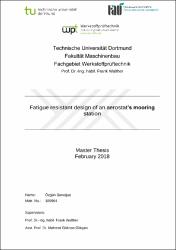| dc.contributor.advisor | Gökçen, Mehmet Gökhan | |
| dc.contributor.advisor | Walther, Frank | |
| dc.contributor.author | Sarıoğuz, Özgün | |
| dc.date.accessioned | 2020-06-29T13:22:19Z | |
| dc.date.available | 2020-06-29T13:22:19Z | |
| dc.date.issued | 2018 | |
| dc.identifier.citation | Sarıoğuz, Ö. (2018). Fatigue resistant design of an aerostat's mooring station. Türk-Alman Üniversitesi, Fen Bilimleri Enstitüsü, İstanbul | en_US |
| dc.identifier.uri | https://hdl.handle.net/20.500.12846/101 | |
| dc.description.abstract | Aerostat bir helyum balonu ve zeminde bağlı olduğu demirleme istasyonundan oluşan "havadan daha hafif" bir gözetleme ve izleme aracıdır. Yüksek irtifalarda aylarca havada durması gerektiğinden, değişen rüzgar kuvveti ve yönleri etkisinde olan dinamik yüklere maruz kalır. Balonun maruz kaldığı bu dinamik yükler doğrudan bağlı olduğu demirleme istasyonundaki metal parçalara etki ettiğinden, bu parçaların tasarımında yorulma ya da metal yorulması gözönünde bulundurulmalıdır. Bu tez çalışması kapsamında önceden tasarlanmış 14 m uzunluğundaki, ayrıca yorulma dayanımlı tasarlanmış 17 m uzunluğundaki iki aerostat demirleme istasyonu yorulma davranışları bakımından incelenmiş, yorulma dayanımlı tasarlanan demirleme istasyonu için ayrıca analitik davranış analizleri ve dinamik yük testleri yapılmış, sonuçlar değerlendirilmiştir. Karşılaştırmalar için yorulma emniyet faktörleri denilen ilgili parçanın öngörülmüş yorulma limitine göre hesaplanan faktörler kullanılmıştır. Bilgisayara dayalı analizlere göre dinamik yük aralığındaki %50 artışa rağmen, 17 m boyutlu büyük aerostat demirleme istasyonu, yorulma dayanımlı tasarımı dolayısıyla, önceki 14 m boyutlu küçük demirleme istasyonuna göre daha iyi değerler göstermiştir. Bilgisayara dayalı analizlerin genel olarak daha fazla parametre içeren ve daha kapsamlı analitik çözümlerden daha ihtiyatlı değerler verdiği ve daha ağır tasarımlara yol açtığı fark edilmiştir. 17 m demirleme istasyonu parçaları için yapılan iki dinamik yükleme testi sonucunda hiçbir yorulma vb. dayalı hasar, kırılma gözlenmemiş, dolayısıyla tasarımlar üretim için kabul edilir görülmüştür. Bu tez çalışması gelecekteki aerostat tasarım projeleri için bir temel kılavuz olarak kullanabilir olup, içeriğindeki bilgisayara dayalı ve analitik davranış analizleri aynı zamanda dinamik testlerin -daha yüksek frekanslar verebilecek test makineleri ile geliştirilerek- tasarım çalışmalarında temel alınabileceği düşünülmüştür. | en_US |
| dc.description.abstract | Aerostat is a lighter-than-air system, consisting of a Helium-filled balloon and a mooring station, which is used for terrain-scaled monitoring applications. During the service at higher altitudes for several weeks to months, the mooring station is subjected to dynamic forces for long period by varying wind magnitudes and directions. The metallic components of the mooring station, which are connected to the balloon with a tether during service and with ropes during landing, are affected by these dynamic loads; therefore, the fatigue mechanisms should be taken into consideration. In the scope of this thesis project, both a previously designed and the new fatigue resistant designed mooring stations of accordingly 14 m and 17 m aerostats were analysed depending on their fatigue behaviour. Besides, life curves and fatigue strengths for the components of fatigue resistant designed mooring station of 17 m aerostat were analytically generated with the help of equations presented by the former academic works. The CAE analyses and analytical generated curves were then verified by the cyclic loading tests for the two mooring station components, flying sheave and tower crane section. For comparison, fatigue safety factors, which were calculated depending on the determined fatigue limits of the components, were utilized. CAE fatigue analysis comparison of the two mooring station designs have shown that, despite an increase in the load range by 50% the large mooring station of 17 m balloon has not shown any significant decrease in fatigue safety factors parallel to this load range increase. The safety factors by analytically generated life curves of the fatigue resistant designed mooring station components were lower than those found by the CAE fatigue analysis and the highest similarity to CAE fatigue analysis results was seen by the analytical generated S-N curve results, which are accepted as more accurate due to more comprehensive parameter usage. In the cyclic load tests of the two components, made of accordingly steel and aluminium, no failure was observed. The results of the thesis work therefore have shown, fatigue resistant design of the mooring station and all the analysis methods within, were reliable and the components were suitable to use under dynamic loads. For future aerostat design projects, use of this fatigue resistant design approach is recommended together by improving it with more comprehensive cyclic load tests with higher frequencies between 20-50 Hz and up to 108 cycles both for the components and specimens. | en_US |
| dc.language.iso | eng | en_US |
| dc.publisher | Türk-Alman Üniversitesi | en_US |
| dc.rights | info:eu-repo/semantics/openAccess | en_US |
| dc.subject | Aerostat demirleme istasyonu | en_US |
| dc.subject | Makine Mühendisliği | en_US |
| dc.subject | Mechanical Engineering | en_US |
| dc.title | Fatigue resistant design of an aerostat's mooring station | en_US |
| dc.title.alternative | Bir aerostat demirleme istasyonunun yorulma dayanımlı tasarımı | en_US |
| dc.type | masterThesis | en_US |
| dc.relation.publicationcategory | Tez | |
| dc.contributor.department | TAÜ, Fen Bilimleri Enstitüsü, İmalat Teknolojisi Ana Bilim Dalı | en_US |
| dc.contributor.institutionauthor | Sarıoğuz, Özgün | en_US |

















